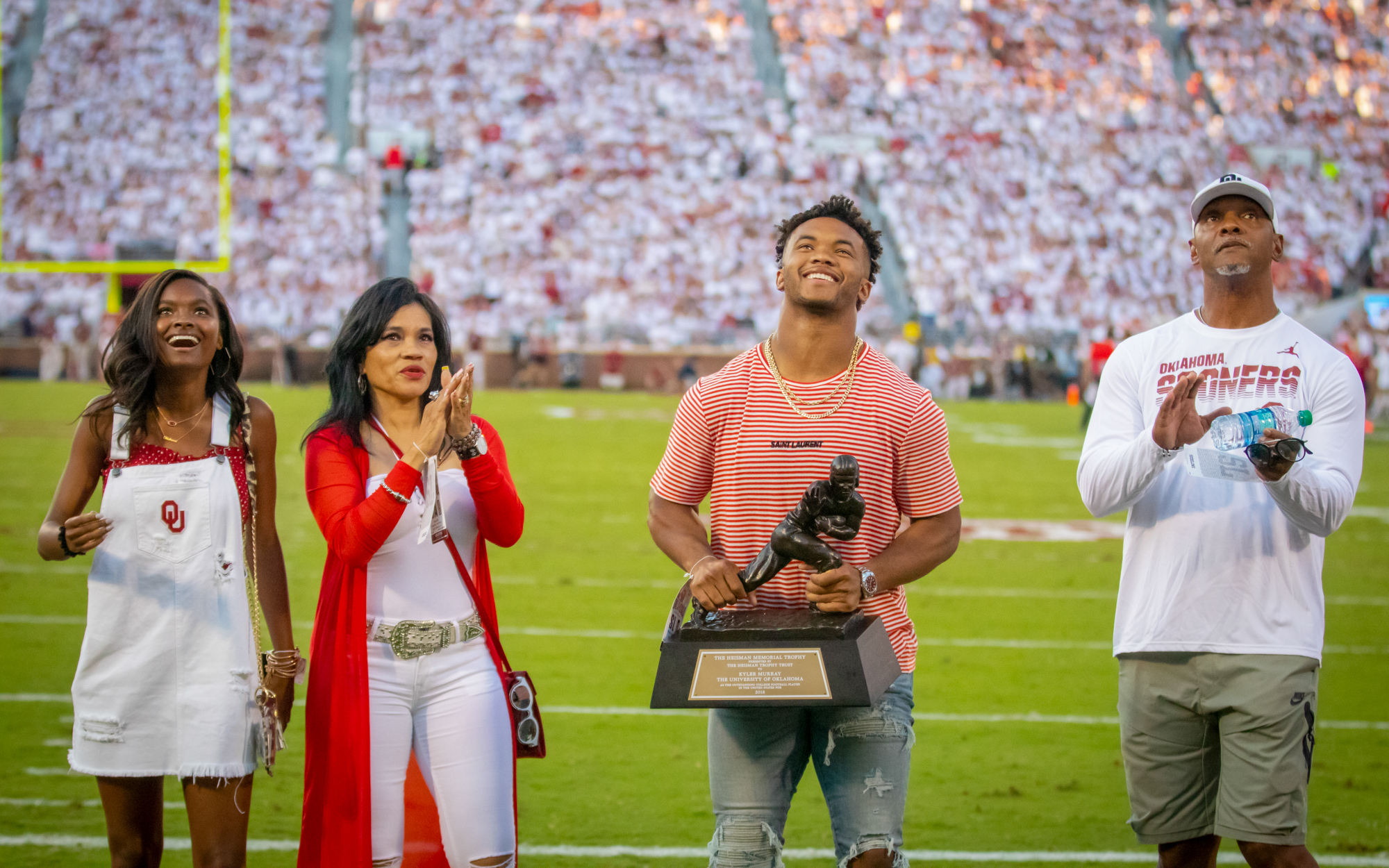
Kyler Murray holds the Heisman Trophy flanked by (from left) his cousin, Carly, his mother, Missy, and his father, Kevin. (Photo by Alex Simon/Cronkite News)
Becoming Kyler Murray: Cardinals quarterback refined skills in heart of football country
By Alex Simon/Cronkite News |
ALLEN, Texas – When Kyler Murray showed up to his first team event at Allen High School after transferring to the school in the summer of 2012, the team’s senior starting quarterback and captain had a pretty quick and clean reaction.
“I laugh at it now, but I was like ‘… that guy,'” said Oliver Pierce, using a colorful verb. “I was like, ‘I ain’t helping him out.'”
It was a reaction a coach would expect from Pierce, who grew up in Allen and dreamed of suiting up as the school’s quarterback one day. Instead, here comes the son of former Texas A&M quarterback Kevin Murray, looking to play the position he was slated to start.
Pierce can laugh about his reaction now because he and Murray remain good friends, even after Murray ended up taking his job during the 2012 season.
And all that Murray has accomplished from that point – three-straight Texas state championships, a 43-0 record as a starter in high school, the ninth overall selection in the 2018 MLB Draft, a Heisman Trophy and the first overall pick in the 2019 NFL Draft – is rooted in that moment.
Pierce doesn’t spend much energy mulling Murray’s achievements at this point. He’s come to expect greatness.
“I’m not really surprised anymore. Like, I didn’t even watch the (NFL) Draft,” Pierce said. “I was just like, ‘He’s going No. 1.’ Heisman winner, No. 1 pick in the draft, It’s pretty incredible. Pretty insane.”
With his first regular-season game in the NFL coming this Sunday when Murray suits up for the Arizona Cardinals, the quarterback said he’s “very excited” about his first crack at professional football.
“First chance as a team to go out and play somebody else,” Murray said on Wednesday. “For me, playing the game of football – obviously there’s a lot of emotions going on – but I always like to keep calm and be myself, trust the game plan, trust myself, and trust my teammates going into it. Go out there, play my game, and let the chips fall where they may.”
Playing his game has worked so far for the 5-foot-10, 207-pound 22-year-old. And with Murray saying there will be “quite a bit” of people coming in to watch him, the path he took to this moment has him ready for this stage.
But no matter what his NFL career turns out to be, he’s already a legend in Allen, Texas, and Norman, Oklahoma.
An impactful move
Murray grew up in Lewisville, a suburban city just north of the Dallas-Fort Worth International Airport and just over 20 miles east of Allen. The city officially incorporated in 1925 but people have lived on the southern side of the Lewisville Lake as far back as the 1840s.
Murray attended Lewisville High School for his freshman year, when both Allen and Lewisville were in the same district and division.

Kyler Murray’s childhood home in Lewisville, Texas. (Photo by Alex Simon/Cronkite News)
Allen’s varsity coach at the time, Tom Westerberg, remembers talking with then-Lewisville coach Dick Olin about Murray since Westerberg had been using Kevin Murray as a quarterback coach for some of his players. But Westerberg missed out on a chance to watch Kevin’s son play because of Mother Nature.
“Allen and Lewisville were actually going to play each other, but the week we were going to play their freshmen team with Kyler at quarterback, a big, huge storm came through, so we had to cancel the game,” Westerberg said. “So, he never played against us and I never got to watch him play until he moved to Allen.”
That move occurred just in time for Murray to come to the start of fall practices. For Pierce, then a senior and the expected starting quarterback, the thing about Murray that stood out was his size – or lack thereof.
“He wasn’t that big,” Pierce said. “I wasn’t big either, but he didn’t have muscle. He was, like, a kid.”
Murray practically was.
His birthday is Aug. 7, meaning he turned 15 just before the Eagles played their first game in his sophomore season. The Texas high school age cutoff date is Sept. 1, which made Murray one of the youngest people in his high school class. The contrast in age stood out to Pierce, who was held back a year.
“This kid’s more than three years younger than me and we’re two grades apart, so I’m way older than him,” Pierce said. “But when he would throw that ball, he could spin it.”
Westerberg stuck with Pierce as his starter in the first game of 2012, an occasion that received plenty of attention nationally.

Eagle Stadium has a capacity of 18,000, but more than 21,000 fans have shown up for games in the past. (Photo by Alex Simon/Cronkite News)
A home unlike any other
A 2009 bond passed by Allen residents allowed the Allen Independent School District to build a new football stadium, and the first game of the 2012 season was the grand opening of 18,000-seat Eagle Stadium.
The final cost: $60 million. It’s a number that Allen athletic director Steve “Bubba” Williams said led to a lot of “shots” of criticism, though not locally.
“We didn’t take any shots from anybody in Texas. We took them from New York and Washington D.C. and the state of Washington, people that don’t understand how finances are distributed in Texas,” Williams said. “They think we can take that money and put it straight into education, but that’s not how it works as far as funding. And the citizens of Allen voted, passed this in a bond and passed this handily. So, this is what the community wanted.”
What the community got was a stadium that is on par with — and even better than — some Division I college stadiums. Eagle Stadium has a horseshoe-style seating arrangement, with the school’s athletic department building located on the southern end and ample parking all around. The press box has three levels, with the school’s Eagle logo at the top visible from at least a mile away, especially when its backlighting kicks on at night. There’s even two entire sections for the student band, aptly called “The Largest Band in the Land” for the 800-plus students in it.
Allen sells up to 8,000 season tickets in its reserved seating section, a number that was larger than the previous stadium’s permanent seating capacity. Lowery Stadium had 7,000 seats, but the school brought in an additional 7,000 temporary seats on a weekly basis. While it made for an incredible football atmosphere – one Pierce said was “freaking sweet” to play in – it was a constant headache for Allen’s longtime athletic director.
“It was a nightmare,” Williams said. “The best thing that could happen to us was when kickoff happened and the game actually started, so we didn’t have to deal with the side issues. We were playing 6A football with a 3A facility.”
Williams expressed with pride that they never shut a game down for capacity issues, though he gives credit to the “special relationship we had with the city” for part of that. That also shines through now with Eagle Stadium, as Williams said the city sends more than two dozen police officers to games. He also has far fewer headaches.
“This place here is so much easier for us to manage, as far as from an administrative standpoint,” Williams said. “We have so much security here that we run this stadium just like a college event. It’s a very manageable deal now for us, compared to what it was.”
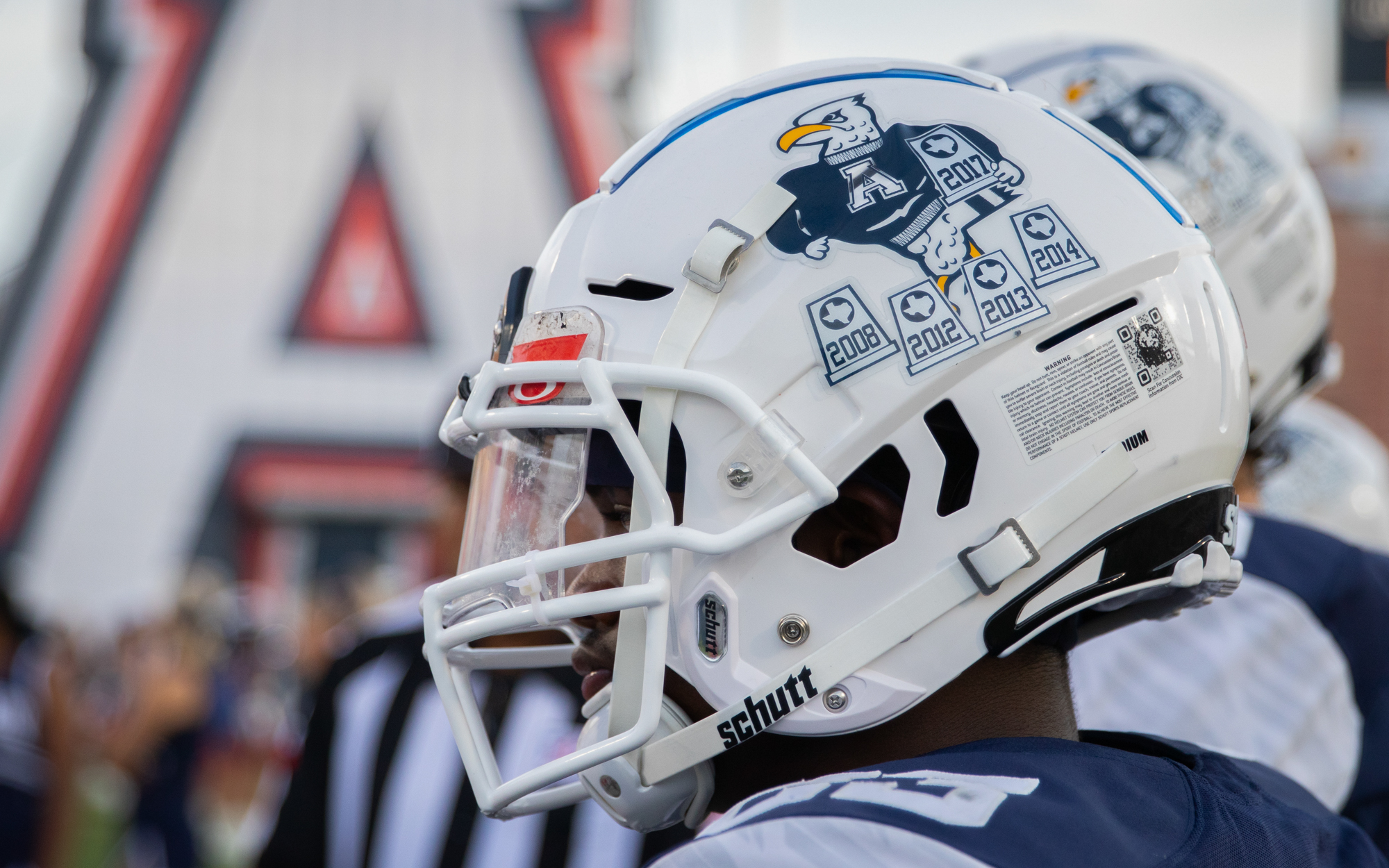
Allen High helmets showcase the school's five state championships; Kyler Murray was the quarterback on three straight title teams, from 2012-2014. (Photo by Alex Simon/Cronkite News)
An inconceivable run of wins
In that first game at Eagle Stadium on Aug. 31, 2012, Allen played Southlake Carroll in front of 21,766 people, plus media from across the country.
What they saw was a 24-0 win for the Eagles, their first over Southlake Carroll in school history. But they also got a glimpse of Murray, who came in for Pierce in the second half and completed 8-of-14 passes for 147 yards.
Pierce continued to start at quarterback for the Eagles as they won their next three games, but Westerberg put Murray in for good when Allen was trailing at Coppell in their fifth game. Murray led a quick comeback, scoring rushing touchdowns on his first two possessions to give Allen the lead. Though Allen lost in overtime, Murray had won the starting job for good and Pierce moved to wide receiver, where he had played previously.
“(That was) the moment for me that I knew (Murray) was better than advertised,” Williams said. “And we got better because (Pierce) went back to receiver. We got stronger at two positions – quarterback and receivers also.”
Pierce acknowledges he “probably cussed out” Westerberg for the switch at first, but he saw Murray’s talent and his youth as something that Allen would want to build off of and quickly readjusted to receiver, where he said he was “comfortable.”
“I just wanted to win – we hadn’t won state. We were the number one team in the country, but we hadn’t won state,” Pierce said. “You put it behind you and you keep going. We never talked about it after that. It was, ‘Let’s go to work.'”
Murray would start his first high school game on Oct. 12, 2012. He would not lose a single game for the remainder of his high school career with 43 straight victories and three consecutive state championships.
“I don’t think (that) anybody could have foresaw the run we went on when he took over,” Westerberg said. “If they could have, that’s pretty good. We knew he was going to be pretty good, but I didn’t – and none of our other coaches did, either – foresee how good we could be.”
Westerberg, like most football coaches, looks back at all the close wins and sees how easily those games could have been losses, but, “boy, the ball bounced our way.” While any team that wins a championship needs luck along the way, Murray’s talent helped create some of that luck.
“It bounced our way a lot, in the games we won with Kyler, but we also won a bunch of games because of him,” Westerberg said. “We won some on special teams and we won because of the ball bouncing our way, but we won them a bunch because of who he was at quarterback.”
As time has passed, a consensus around Allen has formed about the three state championship teams from 2012, 2013 and 2014. The 2012 team used a run-heavy attack, with Westerberg saying the team ran the ball “probably 70 percent” of the time, and had a senior class, led by Pierce and the other captains, that forged the foundation of leadership in the two grades below them.
The 2013 team was the team Westerberg called “special” and Williams declared, “the best team we ever had here.” A blend of an explosive offense and a rock-solid defense, Allen won all but one game — a seven-point win over DeSoto in the state semifinal game — by at least 19 points, including eight wins by at least 35 points.
Then, in 2014, the defense was going to be weaker, but Murray was entering his senior year with a strong cast of offensive players around him. However, well before the season began, an unexpected challenge was thrown at the team and the school when Eagle Stadium had to be shut down because of cracks in the concrete.
The entire 2014 season would be played away from Allen. Despite that, Murray led the Eagles to another undefeated season and a third-straight state championship.
“That’s hard to do, especially in Texas,” Williams said. “I’m prejudiced, but I think the best football’s played in Texas. Athlete-wise, California and Florida have got athletes, but (in terms of) overall program, because of the coaching and off-season situation, I don’t think there’s a better state than Texas.
“To beat the teams we beat, all on the road? The kids didn’t complain, they didn’t bring anything, and they won every one of them.”
We knew he was going to be pretty good, but I didn’t – and none of our other coaches did, either – foresee how good we could be.
Westerberg pointed out that the team was still playing most of its games at stadiums “within a 25-minute drive” of Allen, blending that message with the classic coach mantra, “Don’t worry about the things you can’t control” to say that he felt the team handled it all well.
“It was just something that that was what it was,” Westerberg said. “We just faced it head-on, and I think because our coaches did, our kids did, and it really wasn’t a big deal to us.”
But both Westerberg and Williams agreed that the fact that the team had Murray – the son of a college quarterback and a player with two-time state championships already – helped keep the rest of the team focused on their goals.
“He has an air about him that people know that he is a born leader,” Williams said. “People trust him and they turn to him in those situations. He built that trust and confidence in his teammates.
“Everybody in Allen knew that, as long as you had Kyler you were never out of a game, regardless of what the score was. You still had a chance to win.”
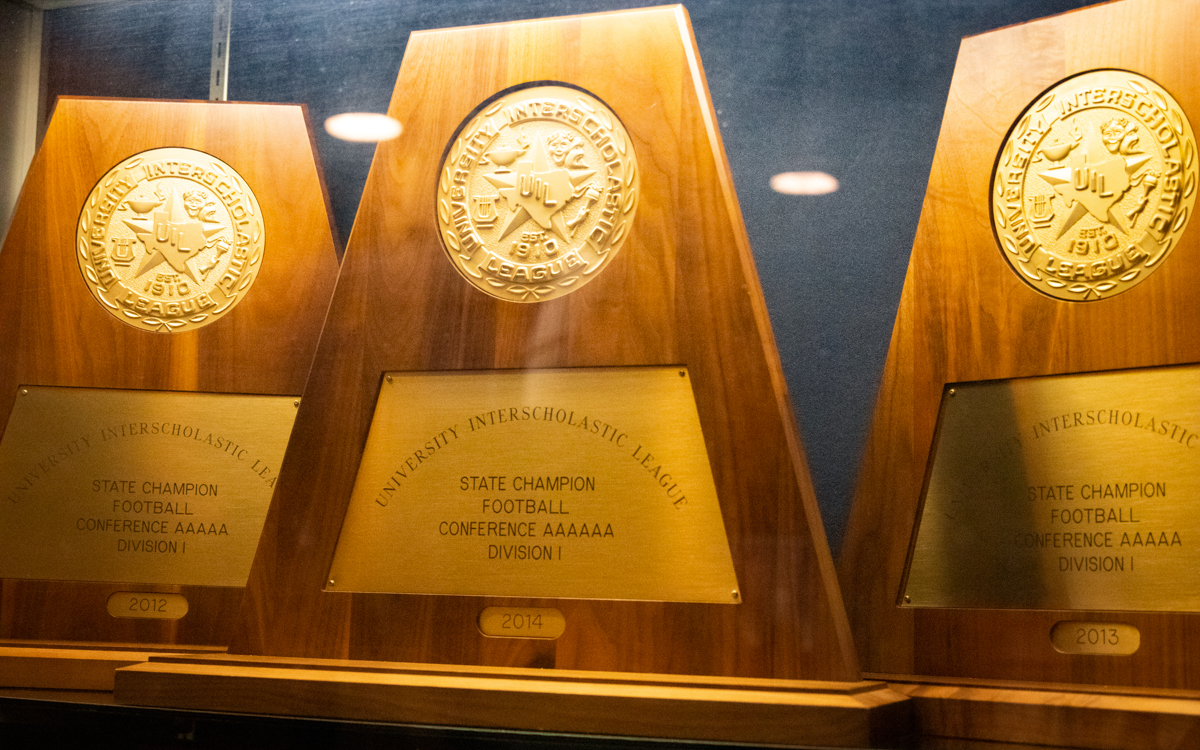
Allen High displays all three of the state championship trophies Kyler Murray helped the program win on a single shelf in Eagle Stadium. (Photo by Alex Simon/Cronkite News)
A change of plans and new home
Environments like Allen are unique in the high school ranks, even in a state as football-crazed as Texas. But when asked how that helped him prepare for his pro career, Murray spun his answer to his most recent career stage.
“I think just playing in front of 16,000 people every week, plus you’re in big games every Friday,” Murray said. “But for me, personally, I think college prepared me more so for the moment.”
That college step started by following his father’s old path to Texas A&M. He signed with the Aggies in 2015 and played in eight games as a freshman, including three starts. But on Dec. 18, 2015, Murray announced he would transfer from Texas A&M, becoming the second top-rated quarterback to leave College Station in a two-week span, following sophomore Kyle Allen, a product of Scottsdale’s Desert Mountain, out the door.
As a former Texas A&M student-manager with the football team, Westerberg said he “hated the deal that happened at A&M,” but he was always on Murray’s side.
“I’m a Kyler Murray fan, and just knowing the kid that he is, knowing his work ethic and what he stands for, it’s fun to watch from outside,” Westerberg said. “(Transferring) was a decision he made with the family and, boy, it worked out.”
Murray didn’t need much time to find his new home, having only wrapped up his high school recruiting process less than a year earlier. As the athletic director at the University of Oklahoma, Joe Castiglione has a hard time keeping up with every athlete his school’s teams are recruiting, but there was no way to miss what Murray was doing at Allen.
“What he was doing in Texas football was something that was of epic proportion,” Castiglione said. “He was catching the imagination of everybody. The team had good players, of course, but they had been doing something they hadn’t done before.”
The two home football stadiums Kyler Murray has starred in so far in his career: Eagle Stadium in Allen, Texas, and Gaylord Family Oklahoma Memorial Stadium in Norman. (Photos by Alex Simon/Cronkite News)
Castiglione said that then-Oklahoma football coach Bob Stoops and his offensive coordinator, Lincoln Riley, called him about the possibility of Murray transferring to Oklahoma. The Sooners had Baker Mayfield at the time, himself a transfer who had just led the team to the College Football Playoff and had two years of eligibility remaining, but Murray would be in line as the backup after he sat out the 2016 season because of transfer rules.
In the end, it took six days, and Murray and Oklahoma made his transfer official on Christmas Eve in 2015. Castiglione remembers thinking about the “incredible momentum” his football program had built offensively that had attracted quarterbacks like Mayfield and Murray to transfer to Norman.
“We’re always trying to recruit the best here,” Castiglione said. “It’s not a cookie-cutter approach. Our job isn’t geared toward making individual people be identical. Our job is finding the ways we can bring out the best in the people we recruit. Different (people) calls for different approaches sometimes.
“But they were really good before they got here. What we’re trying to do is help them be better and try to be the best version of themselves. They find their voice, they find their purpose is strengthened, their confidence in the people in around them gets strengthened.”
And if they find that voice, there’s plenty of people happy to support them in Norman. The success of Oklahoma football over the decades (the school is Top 10 in all time wins in college football history) has helped create a fanatical following. Norman and the school took advantage of opening its 2019 season on a Sunday by hosting an all-day pep rally on Saturday at the college’s Campus Corner, and hundreds of people were in attendance for a rally that didn’t even include the team.
But it did include some former Sooners, including College Football Hall of Famers Joe Washington and Greg Pruitt. The two 1970s running backs received loud cheers when introduced, despite more than half of the crowd appearing to be far too young to remember them playing for Oklahoma. It’s all part of the culture that Castiglione feels Sooner fans and Norman have built for the school.
“This is a big family, and I think what’s special about the University of Oklahoma is that people remember,” Castiglione said. “Our former players come out and the fans, they remember. We’ve got a lot of love for each other here, and there’s a family atmosphere.”
A breakout year in … baseball?
Murray sat out the entire 2016 calendar year but was eligible to begin playing collegiate athletics again in the 2017 spring semester. In the middle of 2016, Oklahoma’s baseball program hired Skip Johnson from the University of Texas to be the Sooners’ pitching coach for the 2017 season.
Johnson, who said he has a good relationship with Murray’s uncle Calvin, a former major league player who was an All-American with the Longhorns, remembered watching Murray play baseball in high school when he coached at Texas, calling him dynamic as an infielder.
But Johnson said the University of Texas “wouldn’t let him do both,” meaning play both football and baseball. Within the single calendar year of 2015, the Longhorns had two chances to recruit Murray to Austin, but Johnson said the football program never brought Murray over to the baseball coaches.
“I think if they would have brought him over, he might have went (to play) baseball and football at Texas,” Johnson said. “Which, thank God, he didn’t.”
In Johnson’s first year at Oklahoma, Murray played baseball for the first time since 2015 during his senior year at Allen, but a shoulder injury limited him to playing as a designated hitter that season. Murray’s 2017 season was his first healthy baseball season in three full years and his stats bore it out. He collected just six hits in 49 at-bats over 27 games and struck out 20 times.
But the flashes of his athletic ability showed in his plate discipline, where he drew 13 walks, and his baserunning, as he stole 12 bases in 13 attempts and scored 16 runs. During the next summer, Murray spent the first month playing in the Cape Cod League, the top collegiate summer baseball league in the country, getting a chance to further develop on the diamond before he went back to football.
Back in Norman, Oklahoma had fired its baseball coach, Pete Hughes, and elevated Johnson to the head coaching job. With help from one of Johnson’s new assistants, Clay Overcash, Murray revamped his swing when he returned to baseball for the 2018 season, adding a leg kick.
“Great athletes, their aptitude is unbelievable like his,” Johnson said. “When he got to work out with us, it was like we were shooting skeet in the building, he was hitting the ball so hard.”
That carried over into a strong 2018 season, where he hit .296 with 10 homers, 13 doubles, 47 RBI, 46 runs and 10 stolen bases in 51 games. Throughout the spring, the buzz around Murray, the baseball player, took off and never stopped through the MLB Draft.
Great athletes, their aptitude is unbelievable like his. When he got to work out with us, it was like we were shooting skeet in the building, he was hitting the ball so hard.
“He’d go over, get in the batting cage, doing things on his own, but he gets out and plays high-level college baseball and had just started practicing weeks before the season started,” Castiglione said. “And then, it just sort of blew up, and we kept hearing, ‘He’s going to get drafted,’ ‘He’s going to get drafted high,’ ‘He’s going to get drafted in the first round,’ and just sort of … ‘Whoa.'”
But even as he was playing baseball, football remained a key focus for Murray, and he was the presumed starter for the 2018 season. Johnson recalls multiple meetings between his baseball staff and the football staff to figure out a schedule for Murray that would allow him to compete in both sports and fit within NCAA rules. Johnson was effusive in his praise for how Sooners football coach Lincoln Riley worked with him to make things work for Murray, calling Riley “selfless.”
“Later in the season, we’re going to TCU and I called Coach Riley a week and a half earlier and said, ‘Hey Coach, this guy’s really helping us,'” Johnson said. “And he said, ‘I see it. I see the same thing.'”
Murray’s schedule was a whirlwind at times.
For instance, on an April Friday in 2018, Murray went to lift weights with the football team in the morning, then flew with an Oklahoma administrator to Fort Worth, Texas, in time for Oklahoma’s 7:15 p.m. baseball game at Texas Christian. Murray blasted two homers and knocked in four runs to lift the Sooners to an 8-5 win over the Horned Frogs that night.
Then he turned around and was in Norman, Oklahoma for Saturday morning football practice before a return flight to Fort Worth for the final two games of the TCU series, which turned out to be a doubleheader Sunday after a weather postponement Saturday. For Johnson, that weekend stands out as the epitome of Murray and the university.
“That’s why you look at the University of Oklahoma and you go, ‘We’re going to do whatever it takes to help the athlete in the means of compliance,'” Johnson said. “Whatever is legal to help the student-athlete, that’s what the University of Oklahoma did for Kyler Murray.”
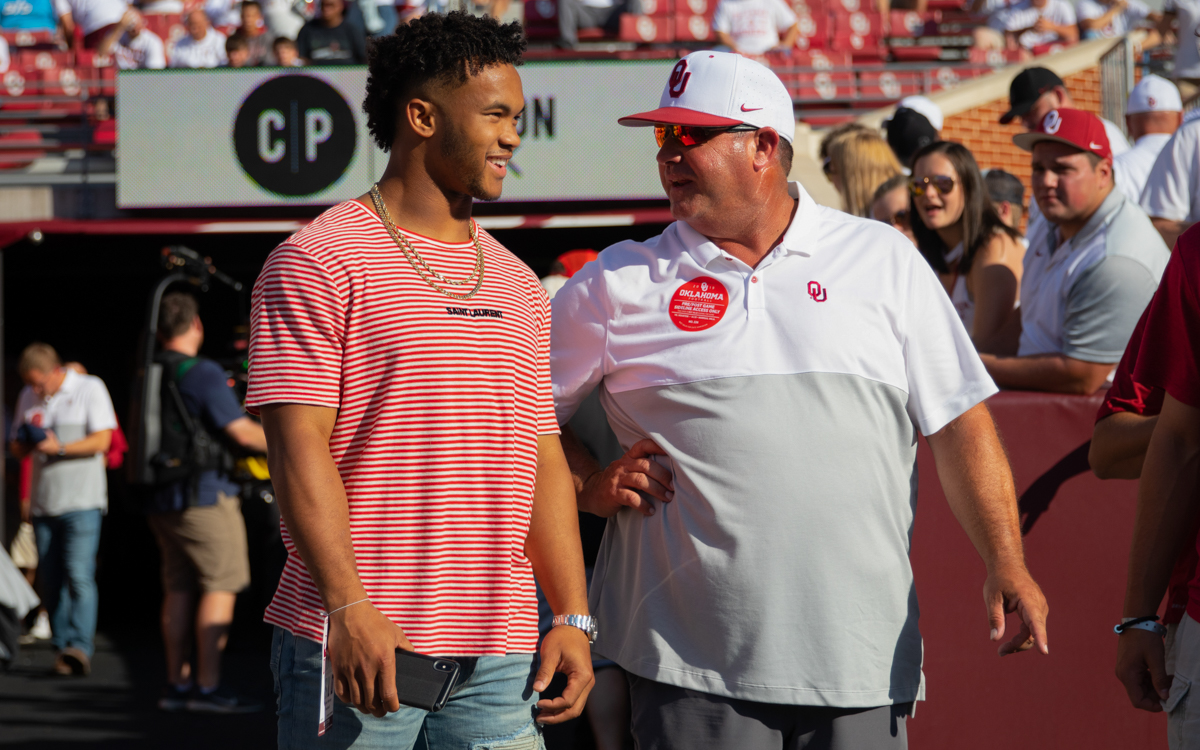
Kyler Murray greets University of Oklahoma head baseball coach Skip Johnson in Murray's return to Norman for the first football game of the 2019 season. (Photo by Alex Simon/Cronkite News)
A draft day surprise, an important clause
On June 4, 2018, Oklahoma’s baseball team was playing in the regional championship game in the NCAA Division I tournament against Mississippi State. Murray had missed the weekend prior to the championship game with a hamstring injury and the Sooners’ other star, Steele Walker, was out with a pulled oblique muscle. But Johnson said Murray called him that morning with a simple message: They were going to play.
When they got to the field, though, that message had to change. Walker’s oblique flared up in the batting cage, and he was ruled out of the game. Murray’s hamstring was acting up as he attempted to run, but he could hit the ball, so he told Johnson to play him as a designated hitter, with a promise that he wouldn’t sprint. But Johnson wasn’t sure he could do that, thinking that Murray’s instinct was to run.
Johnson consulted with Oklahoma’s team doctors, who told him there was an 80 percent chance Murray wouldn’t get hurt. But if he aggravated the injury, it could knock Murray out for six months.
“He goes, ‘Can I give you some advice?’ I said, ‘Yeah.’ He looks at me and he goes, ‘If he gets hurt, they’ll lynch you,'” Johnson said. “I was like, ‘I’m out.’ I knew then, putting two and two together, he can’t play. Well, Kyler was so mad at me.”
Murray’s anger about not playing showed the competitive fire that Johnson loved seeing from his players. But Johnson saw that decision as bigger than the result of that day’s game – a season-ending 8-1 loss – and more about Murray’s long-term health.
“These people can look around here and talk about winning and losing, but it’s not about winning and losing,” Johnson said. “It’s about relationships. When he comes in here, I just want to hug him and ask him how he’s doing.”
Oklahoma may have lost the game that day, but Murray’s career year on the diamond had made him a name to watch in the MLB Draft. However, no one expected he would get selected ninth overall by the Oakland A’s, a slot that carried a value of more than $4.7 million. Baseball America called it the “biggest risk of the draft” a few days later, but Castiglione understood Oakland’s mindset in taking him.
“People forget that that was his first full baseball season,” Castiglione said. “I mean, think about that. Think about that. To go back and look at his college career and what he was able to accomplish in so few games, that’s kind of legendary stuff there.”
Murray signed his contract with the A’s on June 15, 2018, agreeing to a $4.66 million signing bonus that was slightly under the slot value. But in his contract, he agreed to postpone his baseball career until 2019 to give him the chance to play quarterback for the Sooners in 2018.
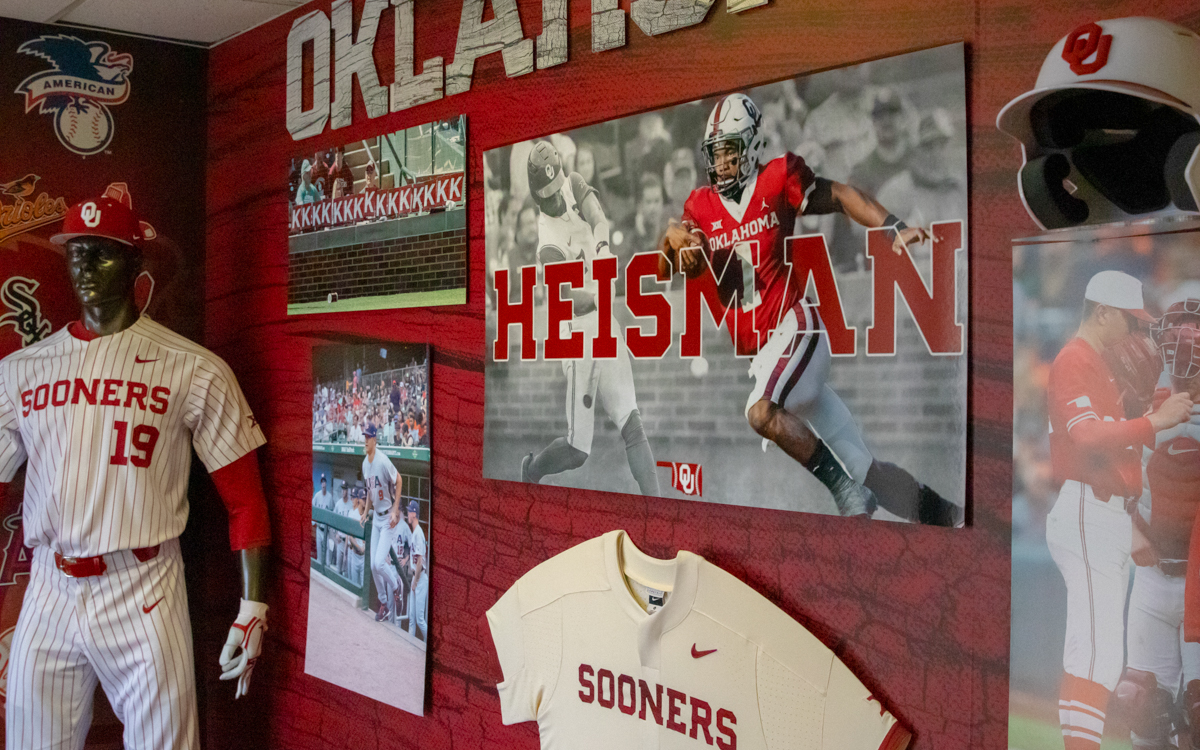
Inside Oklahoma's baseball facility, Kyler Murray's two-sport accolades are highlighted for all Sooner baseball players to see. (Photo by Alex Simon/Cronkite News)
A narrative-busting, award-winning season
As the 2018 summer came to an end and college football season neared, Oliver Pierce’s different athletic worlds began to collide. An elite junior wrestler as well as a football player, Pierce spent time at Oklahoma Junior College after graduating from Allen and then transferred to Arizona State to wrestle. Many of his friends back in Oklahoma were doubting Murray when he arrived in Norman.
“My stupid friends, who didn’t go to Allen that were in school up at OU, they were like, ‘Man, Kyler’s not going to be that good. He’s not going to be better than Baker (Mayfield),’ ” Pierce said. “I was like, ‘Just freaking wait, dude. You have no idea what you’re talking about.'”
For those who remembered Murray from his high school days, it wasn’t a question of whether Murray was going to be good. It was just how good he and Oklahoma would be. The answer was really good.
“I knew they were going to be good. I know Kyler and I know, if he has a pretty good surrounding cast like they had at OU, now you’ve just got to wonder if you’re going to out-score people in college,” Westerberg said. “It wasn’t surprising to watch Kyler go to work.”
Murray had a season for the ages in Norman, finishing with 54 touchdowns (42 passing, 12 rushing) in 14 games, throwing for 4,361 yards and rushing for 1,001. The Sooners went 12-1 in the regular season, winning the Big 12 championship by avenging their only loss to Texas, and earned a spot in the College Football Playoff.
Oh, and Murray gave Oklahoma its second-straight Heisman Trophy winner, matching Mayfield who won it in 2017. Murray was the seventh Heisman Trophy winner from Oklahoma, tying Notre Dame and Ohio State for the most all-time. It was also just the fourth time a school had back-to-back Heisman Trophy winners (not counting USC and Reggie Bush, whose 2005 award was vacated because of NCAA violations).
Castiglione has been the athletic director for four of Oklahoma’s seven Heisman Trophy winners and said that what they all have in common is an understanding that they did not achieve the accolade by themselves.
“It’s given to an individual, but in a lot of ways, it’s a team award,” Castiglione said. “I’ve heard that many, many times from anybody that’s won one. That’s not just humility speaking, that’s just the reality of, ‘I had a lot of really good players and coaches who helped me get to that point.’ Honestly, Kyler really was great.”
Murray and the Sooners lost to top-ranked Alabama in a CFP semifinal in the Orange Bowl, 45-34 despite 308 yards and two touchdowns from Murray on 19-of-37 passing and his 109 yards and another touchdown on the ground.
He has an air about him that people know that he is a born leader. People trust him and they turn to him in those situations. He built that trust and confidence in his teammates. Everybody in Allen knew that, as long as you had Kyler you were never out of a game, regardless of what the score was. You still had a chance to win.
By that point, the buzz surrounding Murray before the MLB Draft baseball had been eclipsed by growing the anticipation around him leading in the NFL Draft.
And while the national narrative at the time expressed doubt and uncertainty about whether Murray would choose football or baseball, there was no question what Murray would choose to people in Allen.
“I think he loves football. I think he’s passionate about football,” Williams said. “I think what he does is he plays baseball when football’s not around, that’s what I always felt like he did. I don’t think he had the same passion for baseball that he has for football.”
Westerberg added, “It’s just different. I always thought he would pick football just because I don’t think he’s as patient of a person. Most people in the major league draft don’t go from getting drafted to directly on a major league team. Whereas in football, if you get drafted high, you’re going to be on the team and expected to play. I don’t think he’s as patient like that, to have to ride through and work your way through the baseball part of it.”
And, as Pierce put it, “We were all like, ‘Pshhh, what? Of course he’d choose football.'”
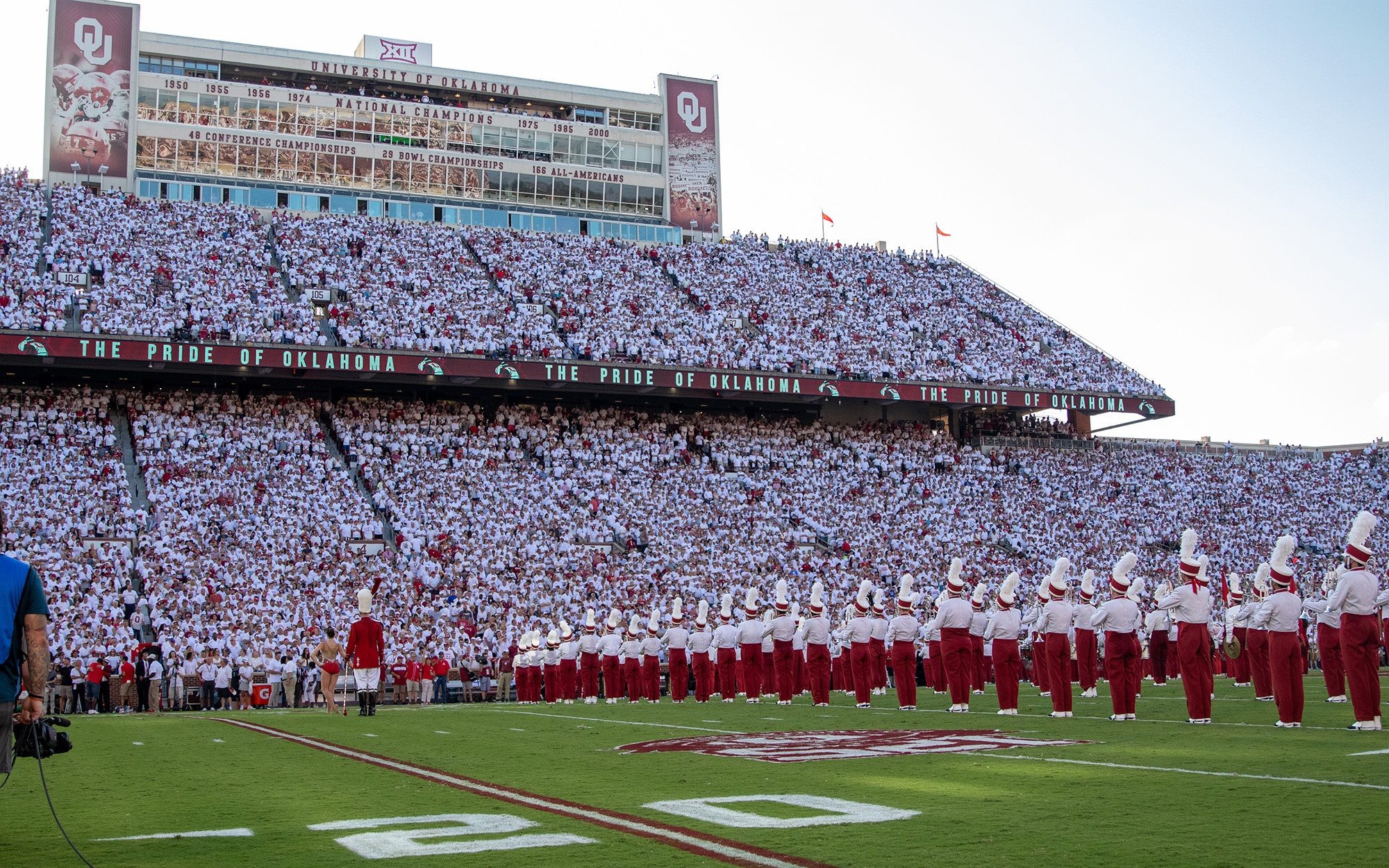
Gaylord Family Oklahoma Memorial Stadium in Norman, which seats more than 84,000, is where the Heisman winner said he got most prepared for an NFL career. (Photo by Alex Simon/Cronkite News)
A top pick prepares for a big debut
But as Murray chose football, football chose Murray, with the Arizona Cardinals selecting him as the first pick in the 2019 NFL Draft. It makes him the first player to ever be selected in the first round of both the NFL and MLB drafts.
The spotlight will constantly follow Murray from this point, but he believes he will handle it just fine, saying the last time he got nervous about football was in his sophomore year at Allen. He is left with a sense of calm as he embarks on his first professional game.
“I’m chilling,” Murray said. “I’m excited for Sunday, obviously, knowing it’s a big day for everybody, (the) start of the season. But we want to start it off the right way, and that’s with a win. (I’m) preparing like any other season for me and preparing myself for this game.”
There will be a lot of pressure on Murray to live up to some enormous expectations. But even if he can reach the pinnacle of the sport at its highest level – Most Valuable Player awards and Super Bowls – those who have watched him since that first season at Allen won’t be surprised.
“If you win the Heisman and you’re the No. 1 pick in the draft, after that, I don’t think you’d be surprised if he’d be an MVP or things like that,” Pierce said.
I’m chilling. I’m excited for Sunday, obviously, knowing it’s a big day for everybody, (the) start of the season. But we want to start it off the right way, and that’s with a win. (I’m) preparing like any other season for me and preparing myself for this game.
Williams added, “There’s no doubt that he is Allen’s favorite son, and everybody in Allen is pulling for him. I’m sure he’s going to have some growing pains, but I don’t think people around here that know him at all have any doubt that he’ll be a successful NFL quarterback.”
The pride Murray has for both Allen and Norman is evident, as a signed picture sits on Williams’ desk that Murray dropped off during the summer in Allen. Murray also returned to Norman last Sunday for the first Sooners game since he left, a chance for the university to show him their love.
“There’s no doubt that this is Kyler’s home. Just like tonight, with him being here and his family being here, this is a home away from home for him,” Castiglione said. “I think everybody helped him feel that way from the moment he stepped on campus. That’s what we do here – you become a Sooner, it’s for life. We don’t let you go. We celebrate that.”
Johnson added, “We just want him to come over here and know that he’s welcomed and that, more than anything, we have open arms for him.”
But what has earned him that undying loyalty from those around him isn’t his on-field performance. It’s who he is away from the spotlight. And that is what won over the quarterback that he took the job from all those years ago.
“I’m not necessarily rooting for Kyler to win MVP, I’m rooting for him as a person,” Pierce said. “(I’m) glad he’s doing what he wants to do, but I’m not necessarily rooting for him to throw 400 yards. I’m rooting for him because he’s from this city right here, I’m rooting for him because he’s a leader. I’m not rooting for him as a fan. I’m rooting for him as a friend.”

Arizona Cardinals quarterback Kyler Murray used his final Sunday before his NFL debut to return to the University of Oklahoma for the school's first football game of 2019. (Photo by Alex Simon/Cronkite News)

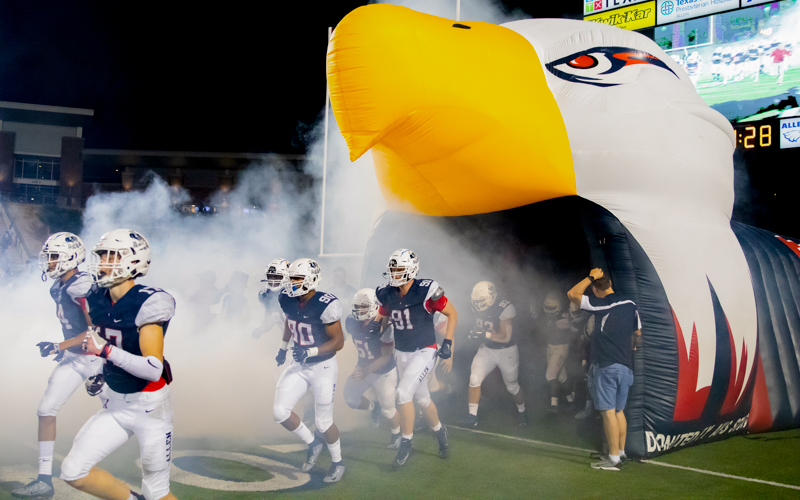

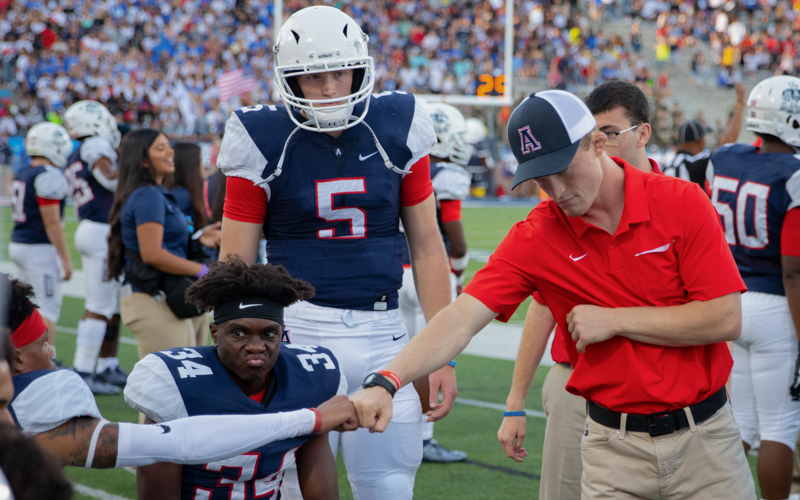

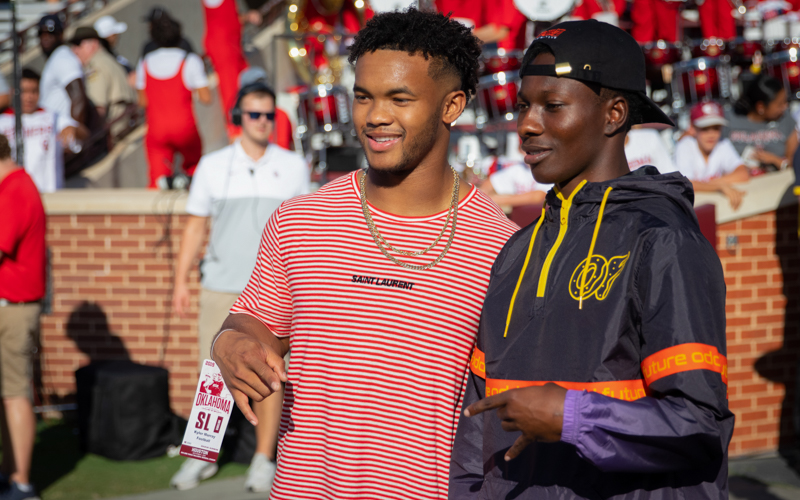
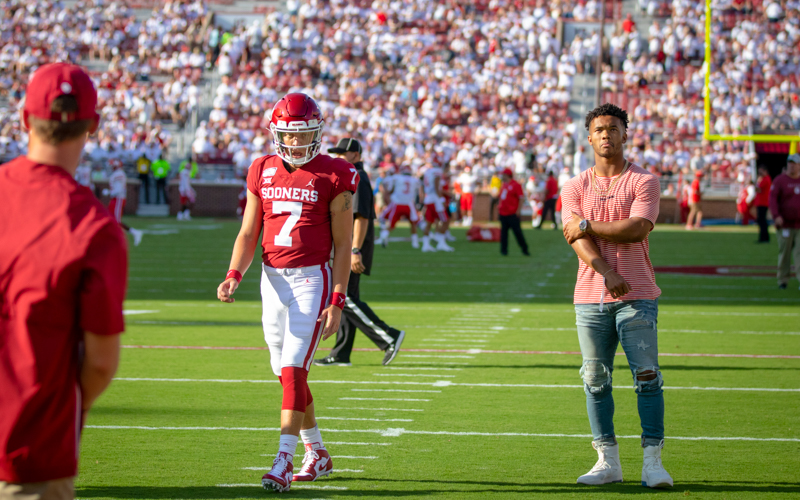
Leave a Comment
[fbcomments]